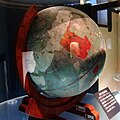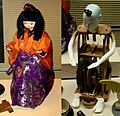National Museum of Nature and Science
国立科学博物館 | |
ueno, Tokyo | |
| Coordinates | 35°42′57″N 139°46′35″E / 35.715939°N 139.776527°E |
|---|---|
| Visitors | 2,884,518 (2017) [2] |
| Website | www |
The National Museum of Nature and Science (国立科学博物館, Kokuritsu Kagaku Hakubutsukan) is in the northeast corner of
History



Opened in 1871, it has had several names, including Ministry of Education Museum, Tokyo Museum, Tokyo Science Museum, the National Science Museum of Japan, and the National Museum of Nature and Science as of 2007.[3] It was renovated in the 1990s and 2000s, and offers a wide variety of natural history exhibitions and interactive scientific experiences.
It was completed as the main building of the Tokyo Science Museum in September 1931 as part of the reconstruction project after the
It is designed to withstand earthquakes of the Great Kanto Earthquake class, and it is said that there is no problem in light of the current Building Standards Act standards.[5]
In 2021, the museum organized the Pokémon Fossil Museum, a travelling exhibition based on the Pokémon franchise, in collaboration with The Pokémon Company. The exhibition opened at the Mikasa City Museum in Mikasa, Hokkaido, Japan, on 4 July 2021, and remained there until 20 September.[6][7] It has since been hosted by several other museums across Japan, including the National Museum of Nature and Science, which hosted it from 15 March to 19 June 2022.[6] A virtual tour of the exhibit as it appeared in the museum was also made available online.[7][8][9]
Materials in the collection
Number of materials
5,004,294 items (as of FY2022).[10] Of these, approximately 14,000 are on permanent display. Others are stored and researched in the Tsukuba area.[11]
- Animal Research Department - 2,346,747 items
- Department of Botany - 2,110,147 items
- Geology Department - 353,270 items
- Humanity Research Department - 163,315 items
- Department of Science and Engineering - 38,815 items
About 100,000 items are newly collected each year.[12]
Designated Cultural Properties


The following items in the collection are designated as national Important Cultural Properties.
- Celestial Globe and Globe by Shibukawa Shunkai (with two old pedestal boards)
- Myriad year clock made in 1695, celestial globe made in 1697.[13][14]
- Hisashige Tanaka : Toshiba
- Made in 1851. Owned by Toshiba. In 1931, it was deposited at the Tokyo Science Museum (predecessor of the National Museum of Nature and Science). Exhibited on the 2nd floor of the Earth Pavilion.[15]
- Astronomical telescope(8-inch flexure equatorial mount) made in UK.
- Made by Troughton & Sims. The first full-scale and largest telescope imported to Japan. Used by the
- seismograph(Appendix: Earthquake Record Vol. 41)
- The oldest existing seismograph in Japan. It was installed in seismologist from England.[17]
- Sogeograph (tin foil gramophone), made in England (attached: wooden box)
- The first phonograph introduced to Japan. On November 16, 1878, at the Hitotsubashi laboratory of the University of Tokyo Faculty of Science, the first sound recording was made in Japan. [18]
- Former Tokyo Science Museum Main Building
- Construction of the building was completed in September 1931 as the main building of the Tokyo Science Museum as part of the reconstruction project following the Great Kanto Earthquake. It was designed in the Ministry of Education Minister's Secretariat's Architecture Division, the building was designated an Important Cultural Property on June 9, 2008.[19]
Exhibition buildings
Nihonkan (Japan Gallery)
The theme of the Ueno Main Building is "Aiming for the coexistence of humankind and nature," and consists of two exhibition halls, the Japan Pavilion and the Earth Pavilion.[20]
-
Zalophus japonicus
-
ammonites
-
Meteoritesfell in Japan
-
Japanese crested ibis (Nipponia nippon)
-
Honshu wolf(Japanese wolf)
-
Paleoparadoxia Skeleton
-
Roosters
-
Foucault pendulum
-
Important Cultural Properties of Japan
-
Important Cultural Properties of Japan
-
Important Cultural Properties of Japan
-
Tsurigane-dokei (hanging bell-shaped clock)
-
The Elekiter (replica) made by Hiraga Gennai
-
Clockwork
-
Clock exhibit
-
Clock exhibit
Chikyūkan (Global Gallery)
The theme is "History of Earth Life and Mankind". The exhibition area is 3 floors above ground and 3 floors below ground.[21] The first phase of construction was completed in 1998. The permanent exhibition will be open to the public from April 24, the following year. Grand opening on November 2, 2004 after the completion of the second phase of construction. The renovation work of the north exhibition hall started in September 2014, and the construction was completed the following year, and the grand opening was held on July 14.
-
Honshu wolf(Japanese wolf)
-
Giant pandas named "Fei Fei" (left) and "Tong Tong" (right)
-
Important Cultural Properties of Japan
-
Dunkleosteus terrelli
-
Karakuri ningyō
-
Hayabusa model
-
Mitsubishi A6M Zero (Zero Fighter) Model 21
-
Zero Fighter Plane Model
-
NAMC YS-11 wind tunnel model
-
Skeleton of sperm whale
-
Animal collection
-
Specimen of giant squid
-
Fossil of Triceratops named "Raymond"
-
largest taxidermy ofMola mola
-
The largest fragment of Nantan meteorite
-
Tyrannosaurus rex
-
Taxidermy Displays
National research facility
Museum research facility
Other National research facilities
- Ueno Zoo
- Tama Zoo
- Tokyo Sea Life Park
Access
 JU JK JY JJ G H Ueno Station
JU JK JY JJ G H Ueno Station- JK JY Uguisudani Station
- KS Keisei Ueno Station
See also
- Institute for Nature Study
- Hachikō
- List of museums
- National Science Museum (disambiguation)
- Tokyo National Museum
- Hisako Koyama
References
- ^ "東京国立博物館の歩み". 東京国立博物館. p. 20. Retrieved 2019-02-27.
- ^ "概要2018" (PDF). 国立科学博物館. p. 20. Retrieved 2019-02-27.
- ^ Profile of the National Museum of Nature and Science 2007, page 23
- ^ 文化庁 プレス発表資料「国宝・重要文化財(建造物)の新指定について」 平成20年4月18日
- 文化庁. Retrieved 2019-02-27.
- ^ a b "巡回展「ポケモン化石博物館」Pokémon Fossil Museum". Kahaku.go.jp. National Museum of Nature and Science. Archived from the original on 20 October 2022. Retrieved 20 October 2022.
- ^ a b Kuhnke, Oisin (14 July 2022). "You Can Now Visit Japan's Pokemon Fossil Museum Virtually". GameSpot. Retrieved 20 October 2022.
- ^ Dinsdale, Ryan (13 July 2022). "Pokémon Fossil Museum Virtual Tour Lets You See the Japanese Exhibit For Yourself". IGN. Retrieved 20 October 2022.
- ^ Miller, Melissa T. (19 July 2022). "Take a Virtual Tour of Pokémon Fossils on Display in Japan". Nerdist. Retrieved 20 October 2022.
- ^ "独立行政法人国立科学博物館概要2023" (pdf). 国立科学博物館.
- ^ 独立行政法人国立科学博物館概要2012
- 読売新聞』朝刊2019年8月11日(くらしサイエンス面)。
- ^ "地球儀". 文化遺産オンライン. 2024-02-27.
- ^ "天球儀". 文化遺産オンライン. 2024-02-27.
- ^ "万年自鳴鐘〈田中久重作/〉". 文化遺産オンライン. 2024-02-27.
- ^ "天体望遠鏡(八インチ屈折赤道儀)〈/英国製〉". 文化遺産オンライン. 2024-02-27.
- ^ "ミルン水平振子地震計〈/英国製〉 附 地震記録四十一巻". 文化遺産オンライン. 2024-02-27.
- ^ "蘇言機(錫箔蓄音機)〈/英国製〉". 文化遺産オンライン. 2024-02-27.
- ^ "旧東京科学博物館本館". 文化遺産オンライン. 2024-02-27.
- ^ "国立科学博物館 日本館".
- ^ "国立科学博物館 地球館".
External links
- National Museum of Nature and Science – official site in English
- National Museum of Nature and Science on Google Cultural Institute












































